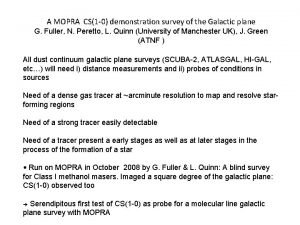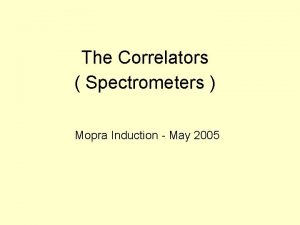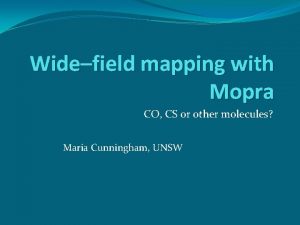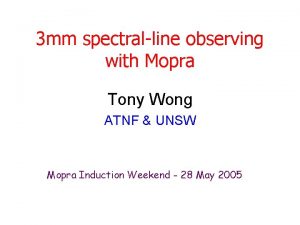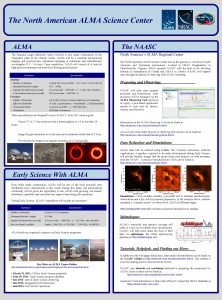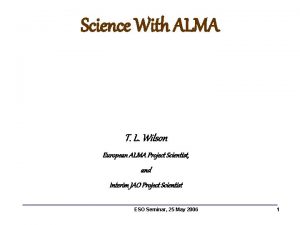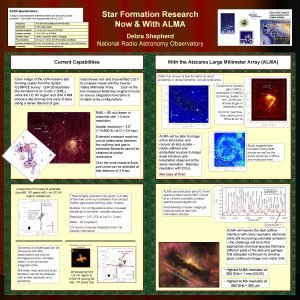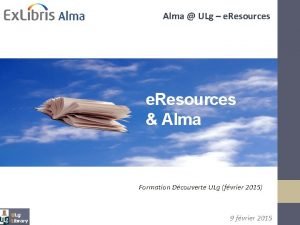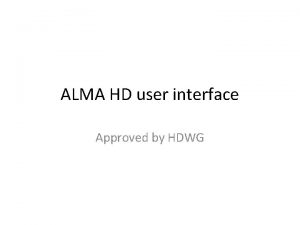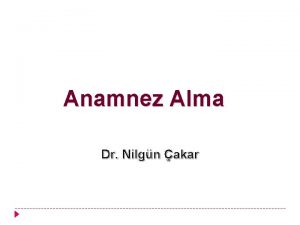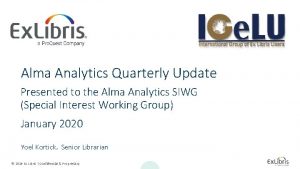ALMA Workshop Science with Mopra for the ALMA




























![Water vapor emission in a high-z lensed SMG Observing frequency [GHz] Pd. BI Omont Water vapor emission in a high-z lensed SMG Observing frequency [GHz] Pd. BI Omont](https://slidetodoc.com/presentation_image/7e8bce705c2415de08a0de2fc60af610/image-29.jpg)
















![Flux density [m. Jy/beam] LSB spectrum (SPW 0/SPW 1) higher frequency part (i. e. Flux density [m. Jy/beam] LSB spectrum (SPW 0/SPW 1) higher frequency part (i. e.](https://slidetodoc.com/presentation_image/7e8bce705c2415de08a0de2fc60af610/image-46.jpg)
![Close up view of SPW 0 Flux density [m. Jy] No CS(7 -6) emission Close up view of SPW 0 Flux density [m. Jy] No CS(7 -6) emission](https://slidetodoc.com/presentation_image/7e8bce705c2415de08a0de2fc60af610/image-47.jpg)
![Flux density [m. Jy/beam] USB spectrum (SPW 2/SPW 3) HCN(4 -3) HCN(v 2=1, l=1 Flux density [m. Jy/beam] USB spectrum (SPW 2/SPW 3) HCN(4 -3) HCN(v 2=1, l=1](https://slidetodoc.com/presentation_image/7e8bce705c2415de08a0de2fc60af610/image-48.jpg)
![Close of views of HCN and HCO+ J=4 -3 Flux density [m. Jy/beam] Very Close of views of HCN and HCO+ J=4 -3 Flux density [m. Jy/beam] Very](https://slidetodoc.com/presentation_image/7e8bce705c2415de08a0de2fc60af610/image-49.jpg)

![Comparison of B 7 line peak fluxes HCN(4 -3) NGC 1097 [m. Jy] 40 Comparison of B 7 line peak fluxes HCN(4 -3) NGC 1097 [m. Jy] 40](https://slidetodoc.com/presentation_image/7e8bce705c2415de08a0de2fc60af610/image-51.jpg)
- Slides: 51

ALMA Workshop "Science with Mopra for the ALMA“ June 9 th 2012, NAOJ, Mitaka, Japan Survey of dense molecular gas in Southern active galaxies using Mopra Kohno Kotaro The University of Tokyo

Why I am here today • I would like to know whether it is feasible or not to use Mopra to detect a few 100 km/s width lines with a noise level of a few m. K (although I know that it is a not easy business!) • If yes, Mopra extragalactic surveys of dense molecular tracers at 3 mm band, including CN, 13 CO, CS, HCN, and HCO+, will be very important toward the understanding of the impact of AGN on the surrounding dense molecular medium.

What I want to achieve: Question: Is this feasible? (how about baseline stability? ) Typical line width: 300 -800 km/s • Typical HCN(1 -0) intensities in these CO bright galaxies (i. e. , CO(1 -0) ~ 0. 4 K in Ta* with SEST 15 m): 10 ~ 20 m. K in Ta* with SEST 15 m 1σ = 3 m. K in Ta* After smoothing down to dv=35 km/s

Outline • Importance of mm/submm spectroscopy of dense molecular medium as a new diagnostic tool of power sources in dusty galaxies • Some examples: NGC 1068 and Arp 220 • What can be seen with Mopra: some lessons from NRO 45 m spectra of nearby AGN (NGC 1068) and starburst galaxies (NGC 253 and IC 342) at 3 mm • Possible targets of Mopra extragalactic dense gas surveys and feasibility • ALMA cycle 0 observations of NGC 1097 at 0. 8 mm (350 GHz) band (if time allows)

Introduction: Importance of mm/submm spectroscopy of dense molecular medium as a new diagnostic tool of the power sources in dusty galaxies

Essential roles of dense molecular gas at the vicinity of active nuclei As a driver of activities • Feeding super massive black holes • Fueling starburst events • Obscuring the broad line regions of AGNs (obscuring torus hypothesis) As a diagnostic tool of power sources • Affected by various types of activities – AGN: hard X-ray, shock (by AGN jet) – Starburst: UV, shock (by SNe), cosmic ray

Major heating mechanisms of ISM in active galaxies • Hard X-ray: forming X-ray dominated regions (XDRs) - Maloney 1999, Ap&SS, 266, 207 • UV: forming HII regions and photo dissociation regions (PDRs) • Cosmic ray heating (mainly from SNe? ) • Mechanical heating: energy injection into the ISM by the dissipation of kinetic energy produced by shock (either AGN jet or SNe? ) – See Meijerink et al. 2011, A&A, 525, A 119 for the effects of cosmic rays and mechanical heating

Mm/submm spectroscopy as a new diagnostic probe of dusty nuclei of galaxies • The idea: To use mm/submm spectral line features as a diagnostic probe of the power source(s) of dusty nuclei of galaxies • Key questions: – What is the characteristic spectral features reflecting the effects of AGN, UV, shocks, cosmic ray, mechanical heating, etc?

Why do we need mm/submm based diagnostics? • Mm/submm lines can penetrate into the dusty nuclei of luminous galaxies – Hard X-ray: Compton thick; NIR/MIR diagnostics also have a limitation to the very dusty nuclei – Can be applied to high-z dusty quasar search? (Schleicher et al. 2010, A&A, 513, A 7) • High angular resolution can be achieved with ALMA – In the ALMA era, we will have very high angular resolution dust continuum images of galaxies (often better than HST etc. ) we have no diagnostic for two close dusty galaxies pair with a separation of <0. 1” !

How to discriminate? • HCN (Kohno et al. 2003, PASJ, 55, L 1; Krips et al. 2008, Ap. J, 677, 262; Harada et al. 2010, Ap. J, 721, 1570) • CN (e. g. , Meijerink et al. 2007, A&A, 461, 793) • Si. O (Garcia-Burillo et al. 2010, A&A, 519, A 2) • CO ladder (Rangwala et al. 2011, Ap. J, 743, 94) • H 2 O (see references in the following slides) • Vibrationally excited HCN (Sakamoto et al. 2010, Ap. J, 725, L 228) & HC 3 N (Costagliola & Aalto 2010, A&A, 515, A 71) • Measuring brightness temperature of dust continuum (Sakamoto et al. 2008, Ap. J, 684, 957; Downes & Eckart, 2007, A&A, 468, L 57)

Elevated HCN in the proto-typical Seyfert galaxy NGC 1068

NGC 1068 (AGN) • Nucleus: RHCN/CO = 0. 54 RHCN/HCO+ = 2. 1 significant enhancement of HCN • Disk (starburst ring): RHCN/CO = 0. 10 RHCN/HCO+ = 1. 3 typical values for starburst regions Kohno et al. 2008, Ap. SS, 313, 279 Helfer & Blitz 1995 12

Millimeter-wave molecular spectroscopy as a new diagnostic of nuclear energy source AGN: CN N=1 -0 J=3/2 -1/2 • HCN/HCO+>2 -3 • CN(J=3/2 -1/2) /(J=1/2 -1/2)~ 1? XDR chemistry? J=1/2 -1/2 Starburst: J= 1/2 -1/2 SB CN N=1 -0 J=3/2 -1/2 1 GHz幅 • HCN/HCO+< 1 • CN(J=3/2 -1/2) /(J=1/2 -1/2)~ 0. 3 PDR chemistry? Nobeyama Millimeter Array Kohno et al. 2008, Ap. SS, 313, 279

A diagnostic method of nuclear power source in dusty galaxies ? “Pure AGN”: Dense molecular medium affected by AGN? Nobeyama Millimeter Array NGC 1068 RHCN/HCO+ Seyfert Starburst “Composite”: AGN with a nuclear starburst ? RHCN/CO Kohno et al. 2001 (astro-ph/0206398) Kohno 2005 (astro-ph/0508420) Kohno et al. 2008, Ap. SS, 313, 279

XDR chemistry in NGC 1068 • The CND of NGC 1068 (~ 100 pc scale) is a giant X -ray Dominated Region (XDR). – Based on Si. O, CN, HCO+, HOC+, H 13 CO+ and HCO lines by IRAM 30 m Also support our view Usero et al. , 2004, A&A, 419, 897 15

変 “HCN Enhanced Nuclei” (HENs) 変 • NGC 1068 (Sy 1. 8):Jackson et al. 1993 (NMA), Tacconi et al. 1994 (Pd. BI), Helfer & Blitz 1995 (BIMA), Kohno et al. 2008, Ap. SS, 313, 279 • NGC 5194 (Sy 2):Kohno et al. 1996, Ap. J, 461, L 29 (NMA) • NGC 1097 (Sy 1):Kohno et al. 2003, PASJ, 55, L 1 (NMA) • NGC 5033 (Sy 1. 5):Kohno et al. 2005, astro-ph/0508420 (NMA) • NGC 6951 (Sy 2): Krisp et al. 2007, A&A, 468, 63 (Pd. BI) • NGC 4501 (Sy 2), NGC 4388 (Sy 2) : Kohno et al. (in prep. ; NMA)

Counter argument: Arp 220?

Arp 220, a proto-typical ultra luminous IR galaxy, also shows an elevated + HCN/HCO ratio • EMIR on IRAM 30 m telescope Still HCN/HCO+ values exceeding 2 are very rare Costagliola et al. 2011, A&A, 528, A 30 The issue: What is the power source of these ULIRGs? Arp 220 HCN/HCO+ = 2. 1 UGC 5101 HCN/HCO+ = 2. 7 +/- ? ?

Excess of HCN(1 -0)/HCO+(1 -0) in Arp 220 (and other ANG-hosting ULIRGs) Imanishi, et al. 2007, AJ, 124, 2366 Nobeyama Millimeter Array

Multi-wavelengths view of Arp 220 L(FIR) ~ 2× 1012 Lo Too dusty for hard X-ray See introduction of Martin et al. 2011, A&A, 527, 36 Av > 100 ma g !? Scoville et al. 1998, Ap. J, 492, L 107 See also Sakamoto+ For double nuclei ⇒ Numerous SNe ? Genzel & Tacconi, 1998, Nature, 395, 859 Downes & Solomon 1998, Ap. J, 507, 615

Recent big surprise provided by Herschel (and Z-Spec/CSO): 1) very high-J CO 2) water vapors

SPIRE-FTS 190 – 670 μm spectrum • df FWHM ~ 1. 44 GHz or d. V = 280 km/s – 950 km/s across the spectral range, beam size = 17” – 40” • Total on-source: 10455 sec = 2. 9 hours – Deep dark sky observations (13320 sec = 3. 7 hours) for the emission from the telescope Rangwala et al. 2011, Ap. J, 743, 94

Arp 220 SPIRE-FTS spectrum Rangwala et al. 2011, Ap. J, 743, 94 • Bright H 2 O lines & very high-J CO lines • Mechanical heating? + AGN? ~50 K ~1350 K ⇔ H 2 rotation temperatures 10% in gas mass but dominating L’co

Mkn 231 Herschel/SPIRE-FTS Van der Werf et al. 2010, A&A, 518, L 42 ~ 1200 GHz coverage !!! R ~ 400 - 1200 • Very high-J CO lines up to J=13 -12 are still well excited !!! • Very rich in species; many bright H 2 O, H 2 O+, OH+ lines

SPIRE-FTS spectrum of M 82, a pure starburst galaxy, is dominated by CO, no H 2 O Panuzzo et al. 2010

PDR vs XDR: 4 major differences • X-ray penetrate much larger column densities than UV photons • Gas heating efficiency in XDRs is very high (1050 %), compared to PDRs (< 1%) • Dust heating much more efficient in PDRs than in XDRs • High ionization levels in XDRs drive ionmolecule chemistry over large column density

Heating source modeling: XDR vs PDR • XDRs produce larger column densities of warmer gas • Identical incident energy densities give very different CO spectra • Very high-J CO lines are excellent XDR tracers • Need good coverage of CO ladder Spaans & Meijerink 2008

CO SEDs of high-z submillimeter galaxies (SMGs) • HLSW 01 is rather similar to Cloverleaf AGN powered? • Orochi: a 10^13 Lo source but likely to be powered only by starburst Inoue Hirofumi et al. , In prep.
![Water vapor emission in a highz lensed SMG Observing frequency GHz Pd BI Omont Water vapor emission in a high-z lensed SMG Observing frequency [GHz] Pd. BI Omont](https://slidetodoc.com/presentation_image/7e8bce705c2415de08a0de2fc60af610/image-29.jpg)
Water vapor emission in a high-z lensed SMG Observing frequency [GHz] Pd. BI Omont et al. 2011, A&A, 530, L 3 Z-Spec/CSO Lupu et al. 2010, Ap. J, submitted (ar. Xiv: 1009. 5983) SDP. 17 b, z=2. 305 H 2 O 20, 2 -11, 1

Water vapor at z=3. 91 Bradford et al. 2011, Ap. J, 743, 167 z=3. 911 Z-Spec/CSO Van Der Werf et al. 2011, A&A, 741, L 38 ↓ Pd. BI Observing frequency [GHz] Para H 2 O 22, 0 -21, 1 Pd. BI Lis et al. 2011, Ap. J, 738, L 6

Level diagram of water lines スピン平行 スピン反平行 Van Der Werf et al. 2011, A&A, 741, L 38 ping f=1208 GHz Eu/k=454 K iati v Rad f=557 GHz Not detected Eu/k=61 K pum f=988 GHz Eu/k=101 K Radi ative f=1229 GHz Lis et al. 2011 ep um pin g f=1163 GHz Eu/k=305 K Tdust =220 K Weiss et al. 2007, A&A, 467, 955 Riechers et al. 2009, Ap. J, 690, 463 f=752 GHz Eu/k=137 K Cricital densities ~ 10^8 cm-3 !!

Water lines in APM 08279+5255 are very different from those in PDRs 21, 1 -20, 2/11, 0 -10, 1 ratio > 8 !!! Collisional excitation is unlikely. . – thermal level populations: 21, 1 -20, 2/11, 0 -10, 1 ratio is 0. 6 in Orion bright bar (PDR): White et al. 2010, A&A, 518, L 114; Habart et al. 2010, A&A, 518, L 116 Populated by the absorption of FIR photons Excited by collision – much fainter than CO lines in the same freq. range: H 2 O 21, 1 -20, 2 /CO(6 -5) luminosity ratio is 0. 026 in Orion bar ⇔ 0. 6 ! in APM 08279 Radiative pumping Unimportant as a coolant of warm dense gas?

Interim summary • Mm/submm spectra contain rich information on the impact of the power sources onto the surrounding dense interstellar medium. • Although we need further studies (with ALMA) on the spatially resolved physical and chemical properties of dense ISM in both AGN and starburst galaxies, 3 mm lines such as HCN can be a diagnostic probe of AGN.

What can be seen with Mopra: Key features at 3 mm band Some lessons from unbiased spectral line scans at 3 mm using NRO 45 m telescope (and supporting evidence by ALMA cycle 0 data!) toward nearby AGN and starbursts

Unbiased line surveys with NRO 45 m SAM 45+PANDA+T 100/TZ 100 on NRO 45 m telescope 30 GHz coverage, 0. 5 HCN(1 -0)/CS(2 -1) MHz resolution @100 GHz R~2 x 105, dv~1. 5 km/s > 5 @NGC 1068 32 GHz coverage (AGN) sub-m. K sensitivity Nakajima, Takano, Kohno et al. 2011, Ap. J, 728, L 38; in prep. HCN(1 -0)/CS(2 -1) < 2 @NGC 253, IC 342 (starburst) 85 90 95 Frequency [GHz] 110 115

Unbiased line surveys with NRO 45 m SAM 45+PANDA+T 100/TZ 100 on NRO 45 m telescope 30 GHz coverage, 0. 5 MHz resolution @100 GHz R~2 x 105, dv~1. 5 km/s CN(N=1 -0)>13 CO(1 -0) @NGC 1068 (AGN) 32 GHz coverage sub-m. K sensitivity Nakajima, Takano, Kohno et al. 2011, Ap. J, 728, L 38; in prep. CN(N=1 -0)<13 CO(1 -0) @NGC 253, IC 342 (starburst) 85 90 95 Frequency [GHz] 110 115

Then, why not use Mopra!

Importance of Mopra • Measuring the intensities of major dense gas tracers at 3 mm toward CO bright southern galaxies – Many (possibly) CO bright southern galaxies remain unexplored yet! • Key lines are: CN(N=1 -0), 13 CO(J=1 -0), CS(J=2 -1), HCO+(J=1 -0), HCN(J=1 -0) – Mopra measures ground state lines, whereas ASTE observes higher order lines multi N/J measurements are essential to quantify the abundance and excitation separately. – Single dish measurements an indispensable step toward ALMA proposals (high resolution imaging)

Southern (<-35 deg) gas rich (>0. 1 K in SEST) active spiral galaxies in Ta* scale Name Decl. Activity CO(1 -0) brigthness (SEST 15 m, Ta*) NGC 4945 -49 deg Sy 2+SB 1. 3 K Curran et al. 2001, A&A, 367, 457 NGC 986 -39 deg SB 0. 4 K Elfag et al. 1996, A&A Suppl. 115, 439; see also CO(3 -2) ASTE, Kohno et al. 2008, PASJ, 60, 457 Circinus -65 deg Sy 2+SB? 0. 4 K Curran et al. 2001, A&A, 367, 457 NGC 1365 -36 deg Sy 1. 8 0. 4 K Elfag et al. 1996, A&A Suppl. 115, 439 NGC 3256 -43 deg SB? 0. 3 K Casoli et al. 1992, A&A, 264, 49 NGC 7552 -42 deg Sy 2+SB 0. 2 K Claussen & Sahai 1992, AJ, 103, 1134 (also CO(3 -2) ASTE, HCN(1 -0) etc w/ ATCA) NGC 1808 -37 deg Sy 2 0. 2 K Aalto et al. 1994, A&A, 286, 365 NGC 7130 -35 deg SB? 0. 17 K Elfag et al. 1996, A&A Suppl. 115, 439 NGC 1672 -59 deg AGN+SB? 0. 13 K Bajaja et al. 1995, A&A Suppl. 114, 147 (also CO(3 -2) ASTE) NGC 7582 -42 deg Sy 1+SB? 0. 13 K Claussen & Sahai 1992, AJ, 103, 1134 NGC 3620 -76 deg SB? 0. 12 K Elfag et al. 1996, A&A Suppl. 115, 439 NGC 2369 -62 deg SB? 0. 12 K Elfag et al. 1996, A&A Suppl. 115, 439

ASTE CO(3 -2) observations of some Southern spirals have been started • Discovery of “dense gas rich bar” in NGC 986 dynamically young bar? Kohno et al. , 2008, PASJ, 60, 457

What I want to achieve: Question: Is this feasible? (how about baseline stability? ) Typical line width: 300 -800 km/s • Typical HCN(1 -0) intensities in these CO bright galaxies (i. e. , CO(1 -0) ~ 0. 4 K in Ta* with SEST 15 m): 10 ~ 20 m. K in Ta* with SEST 15 m 1σ = 3 m. K in Ta* After smoothing down to dv=35 km/s

Summary • Importance of mm/submm spectroscopy of dense molecular medium as a new diagnostic tool of power sources in dusty galaxies • Some examples: NGC 1068 and Arp 220 • What can be seen with Mopra: some lessons from NRO 45 m spectra of nearby AGN (NGC 1068) and starburst galaxies (NGC 253 and IC 342) at 3 mm • Possible targets of Mopra extragalactic dense gas surveys and feasibility • ALMA cycle 0 observations of NGC 1097 at 0. 8 mm (350 GHz) band (if time allows)

ALMA cycle 0 band 7 data of the southern AGN+SB hybrid galaxy NGC 1097 PI. =K. Kohno, ID=2011. 0. 00108 S Special thanks to Daniel Espada

Active nucleus of NGC 1097 • CO(2 -1)/CO(1 -0) =1. 8 ± 0. 2 • Presence of strong heating source(s) is suggested ! In Tb scale CO(1 -0) NMA CO(2 -1) SMA 1 kpc VLT MELIPAL + VIMOS 1 kpc Hsieh et al. , 2008, Ap. J, 683, 70 Kohno et al. 2003 PASJ, 55, L 1

ALMA cycle 0 band 7 observations • Two observing runs @Compact configuration – 5 th Nov. 2011, UT 06: 51 -07: 54, 14 ant, (on~28 min. ) – 6 th Nov. 2011, UT 02: 05 -03: 09, 15 ant, (on~28 min. ) • Calibrators – Bandpass: J 0522 -364, visibility : J 0334 -401 + Callisto • Achieved noise level – ~2. 1 m. Jy@LSB, ~2. 3 m. Jy @USB @df=9. 766 MHz • cf. on-source 1. 1 hrs is required according to OT mostly consistent with the OT’s expectations ! • This noise level is compatible to that in typical one night SMA continuum imaging for SMGs (~2 m. Jy rms) !!!
![Flux density m Jybeam LSB spectrum SPW 0SPW 1 higher frequency part i e Flux density [m. Jy/beam] LSB spectrum (SPW 0/SPW 1) higher frequency part (i. e.](https://slidetodoc.com/presentation_image/7e8bce705c2415de08a0de2fc60af610/image-46.jpg)
Flux density [m. Jy/beam] LSB spectrum (SPW 0/SPW 1) higher frequency part (i. e. , blue shifted) of the emission Is chopped CS(7 -6) HC 15 N(4 -3) H 13 CN(4 -3) Before CLEAN Observed Frequency [GHz]
![Close up view of SPW 0 Flux density m Jy No CS7 6 emission Close up view of SPW 0 Flux density [m. Jy] No CS(7 -6) emission](https://slidetodoc.com/presentation_image/7e8bce705c2415de08a0de2fc60af610/image-47.jpg)
Close up view of SPW 0 Flux density [m. Jy] No CS(7 -6) emission !! f_rest = 342. 883 GHz f_obs = 341. 449 GHz HC 15 N(4 -3) < 4. 2 m. Jy (2σ upper limit) Superb ALMA sensitivity imposes a significant, meaningful upper limit if we compare the CS(7 -6) with HCN(4 -3). Observing frequency [GHz] f_obs ~ 342. 75 GHz 1σ ~2. 1 m. Jy for dv=8 km/s !!!
![Flux density m Jybeam USB spectrum SPW 2SPW 3 HCN4 3 HCNv 21 l1 Flux density [m. Jy/beam] USB spectrum (SPW 2/SPW 3) HCN(4 -3) HCN(v 2=1, l=1](https://slidetodoc.com/presentation_image/7e8bce705c2415de08a0de2fc60af610/image-48.jpg)
Flux density [m. Jy/beam] USB spectrum (SPW 2/SPW 3) HCN(4 -3) HCN(v 2=1, l=1 f, J=4 -3) f_rest = 356. 256 GHz, f_obs = 354. 766 GHz HCO+(4 -3) ? ! Observed Frequency [GHz] 1σ ~2. 3 m. Jy
![Close of views of HCN and HCO J4 3 Flux density m Jybeam Very Close of views of HCN and HCO+ J=4 -3 Flux density [m. Jy/beam] Very](https://slidetodoc.com/presentation_image/7e8bce705c2415de08a0de2fc60af610/image-49.jpg)
Close of views of HCN and HCO+ J=4 -3 Flux density [m. Jy/beam] Very good S/N as if they were CO !!! Incredible !!! Observing frequency [GHz]

Striking difference of B 7 spectra between NGC 1097 and NGC 4418 Sakamoto et al. 2010, Ap. J, 725, L 228 NGC 4418 spectra CS(7 -6) ~ 66 m. Jy Significant radiative excitation of HCN(4 -3) ~ 133 m. Jy HCN(v 2=1) ~ 30 m. Jy HCN(4 -3)/CS(7 -6) ~ 2. 0 @4418, > 10 @1097 HCO+(4 -3) ~ 82 m. Jy Weakness of CS w. r. t. HCN is evident in NGC 1097 enhancement of HCN? !
![Comparison of B 7 line peak fluxes HCN4 3 NGC 1097 m Jy 40 Comparison of B 7 line peak fluxes HCN(4 -3) NGC 1097 [m. Jy] 40](https://slidetodoc.com/presentation_image/7e8bce705c2415de08a0de2fc60af610/image-51.jpg)
Comparison of B 7 line peak fluxes HCN(4 -3) NGC 1097 [m. Jy] 40 NGC 4418 [m. Jy] 133 Ori-KL [K] in Tmb 50 R-Cr. A [K] in Tmb 4. 3 HCO+(4 -3) 23 82 47 19. 6 HCN(v 2=1, J=4 -3) CS(7 -6) <4. 6 30 7 <0. 06 <4. 2 63 29 5 CO(3 -2) ~900 746 145 35 Schilke+, 1997, Ap. JS, 108, 301 Watanabe+ 2012 Ap. J, 745, 126 This work HCN(v 2=1, 4 -3)/ HCN(4 -3) <0. 12 Sakamoto+ 2010, Ap. J, 725, L 228 0. 23 0. 14 <0. 014 HCN(4 -3)/CS(7 -6) > 10 2. 0 1. 7 NGC 4418 is very similar to massive. SF regions, whereas the nucleus of NGC 1097 is different from them 0. 86
 Mi az almárium
Mi az almárium Her favourite subject is english
Her favourite subject is english Sembolik model alma örtük model alma
Sembolik model alma örtük model alma Iso 22301 utbildning
Iso 22301 utbildning Typiska novell drag
Typiska novell drag Nationell inriktning för artificiell intelligens
Nationell inriktning för artificiell intelligens Vad står k.r.å.k.a.n för
Vad står k.r.å.k.a.n för Varför kallas perioden 1918-1939 för mellankrigstiden
Varför kallas perioden 1918-1939 för mellankrigstiden En lathund för arbete med kontinuitetshantering
En lathund för arbete med kontinuitetshantering Personalliggare bygg undantag
Personalliggare bygg undantag Personlig tidbok för yrkesförare
Personlig tidbok för yrkesförare Sura för anatom
Sura för anatom Förklara densitet för barn
Förklara densitet för barn Datorkunskap för nybörjare
Datorkunskap för nybörjare Boverket ka
Boverket ka Debatt mall
Debatt mall Magnetsjukhus
Magnetsjukhus Nyckelkompetenser för livslångt lärande
Nyckelkompetenser för livslångt lärande Påbyggnader för flakfordon
Påbyggnader för flakfordon Formel för lufttryck
Formel för lufttryck Publik sektor
Publik sektor Jag har nigit för nymånens skära text
Jag har nigit för nymånens skära text Presentera för publik crossboss
Presentera för publik crossboss Argument för teckenspråk som minoritetsspråk
Argument för teckenspråk som minoritetsspråk Vem räknas som jude
Vem räknas som jude Treserva lathund
Treserva lathund Mjälthilus
Mjälthilus Claes martinsson
Claes martinsson Centrum för kunskap och säkerhet
Centrum för kunskap och säkerhet Programskede byggprocessen
Programskede byggprocessen Bra mat för unga idrottare
Bra mat för unga idrottare Verktyg för automatisering av utbetalningar
Verktyg för automatisering av utbetalningar Rutin för avvikelsehantering
Rutin för avvikelsehantering Smärtskolan kunskap för livet
Smärtskolan kunskap för livet Ministerstyre för och nackdelar
Ministerstyre för och nackdelar Tack för att ni har lyssnat
Tack för att ni har lyssnat Referatmarkeringar
Referatmarkeringar Redogör för vad psykologi är
Redogör för vad psykologi är Stål för stötfångarsystem
Stål för stötfångarsystem Tack för att ni har lyssnat
Tack för att ni har lyssnat Borra hål för knoppar
Borra hål för knoppar Vilken grundregel finns det för tronföljden i sverige?
Vilken grundregel finns det för tronföljden i sverige? Variansen formel
Variansen formel Tack för att ni har lyssnat
Tack för att ni har lyssnat Steg för steg rita
Steg för steg rita Vad är verksamhetsanalys
Vad är verksamhetsanalys Tobinskatten för och nackdelar
Tobinskatten för och nackdelar Toppslätskivling effekt
Toppslätskivling effekt Mästare lärling modell
Mästare lärling modell Egg för emanuel
Egg för emanuel Elektronik för barn
Elektronik för barn Fredsgudinnan
Fredsgudinnan
























































